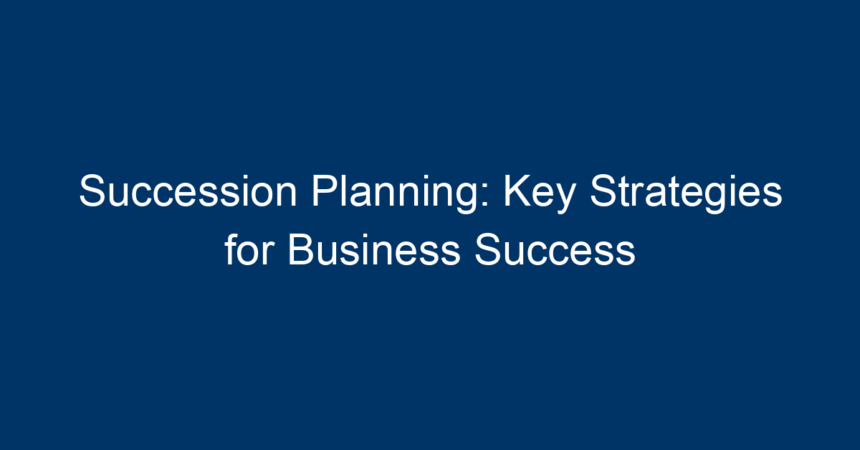In today’s fast-paced business environment, effective succession planning is vital for ensuring the longevity and stability of any organization. As leadership transitions occur due to retirement, unexpected departures, or strategic changes, having a robust succession plan can mean the difference between continuity and chaos. In this article, we will explore key strategies for effective succession planning that can ensure your business thrives, even in times of change.
What is Succession Planning?
Succession planning is the strategic process of identifying and developing internal personnel to fill key leadership roles within an organization. It involves not only recognizing potential leaders but also implementing training and development programs to prepare those individuals for future responsibilities. A well-designed succession plan addresses critical positions and creates a seamless transition that promotes business continuity.
Why is Succession Planning Important?
Succession planning is essential for several reasons:
- Ensures Continuity: It helps prevent disruptions in leadership, maintaining organizational stability.
- Retains Talent: By investing in employees’ career development, businesses can enhance employee engagement and retention.
- Reduces Risks: A comprehensive succession plan can minimize the risk associated with sudden departures or retirements.
- Promotes Organizational Knowledge: It ensures that valuable institutional knowledge is passed down through generations of leaders.
By prioritizing succession planning, businesses position themselves to adapt and thrive in an ever-evolving marketplace.
Key Strategies for Effective Succession Planning
1. Assess Organizational Needs
Before diving into the succession planning process, it’s crucial to assess your organization’s current and future needs. Conduct a thorough analysis of your business’s strategic goals and objectives. Identify key leadership roles that will be critical for achieving these goals.
Action Steps:
- Evaluate existing leadership roles and their impact on organizational success.
- Identify potential gaps in leadership and areas where future leaders may be needed.
- Consider the long-term goals of your organization to foresee necessary leadership skills.
2. Identify Potential Leaders
Once you understand your organization’s needs, the next step is to identify potential leaders within your organization. This involves recognizing individuals who show promise and possess qualities necessary for effective leadership, such as emotional intelligence, adaptability, and strategic thinking.
Action Steps:
- Use performance reviews and employee evaluations to spot high-potential candidates.
- Encourage managers to recognize and nominate individuals who demonstrate leadership qualities.
- Diversify the leadership pipeline by considering candidates from various backgrounds and departments.
3. Develop Comprehensive Training Programs
Identifying potential leaders is just the first step; you must also invest in their development. Tailoring training programs that cater to the specific needs of future leaders will help them gain the necessary skills and experience to step into leadership roles confidently.
Action Steps:
- Create mentorship programs where current leaders guide and train potential successors.
- Offer leadership training workshops focused on specific skills such as decision-making, communication, and conflict resolution.
- Encourage job rotation or cross-training to provide future leaders with a broader perspective of the organization.
4. Foster a Culture of Leadership Development
For succession planning to be successful, it must be woven into the fabric of your organization’s culture. Fostering a culture that values and promotes leadership development encourages employees to view leadership roles as attainable and desirable.
Action Steps:
- Communicate the importance of succession planning throughout the organization to align everyone with its objectives.
- Recognize and celebrate accomplishments of future leaders to motivate others.
- Create opportunities for employees to lead smaller projects or initiatives, providing them with practical experience.
5. Implement Regular Review and Update Processes
Succession planning is not a one-time effort; it requires ongoing evaluation and updates. As your business grows and changes, so do the needs and potential candidates for leadership roles. Regular reviews ensure your succession plan remains relevant and effective.
Action Steps:
- Set a schedule for regular reviews of your succession plan, ideally every one to two years, to assess its effectiveness.
- Gather feedback from employees, especially those in leadership roles, on the viability and impact of the succession plan.
- Adjust training and development programs based on new business challenges and changes in organizational structure.
The Role of Technology in Succession Planning
In today’s digital age, technology plays a critical role in enhancing succession planning processes. Tools like Applicant Tracking Systems (ATS), Learning Management Systems (LMS), and performance management software can streamline the identification and development processes.
Action Steps:
- Utilize data analytics to track employee performance and identify potential leaders effectively.
- Leverage online training platforms to provide flexible, accessible learning opportunities for future leaders.
- Implement collaboration tools to encourage knowledge-sharing among employees and potential leaders.
Overcoming Common Challenges in Succession Planning
While implementing succession planning strategies, organizations may encounter challenges such as resistance to change, lack of resources, or unclear expectations. Addressing these challenges head-on can significantly enhance the effectiveness of your succession plan.
Action Steps:
- Communicate the benefits of succession planning to alleviate concerns and encourage buy-in from all levels of the organization.
- Allocate sufficient resources and budget for training and development programs, ensuring employees have the tools they need to succeed.
- Clarify roles and expectations for both current leaders and potential successors to minimize uncertainty during transitions.
Conclusion: Taking Action for Future Success
Succession planning is more than just filling leadership positions; it’s about securing the future success of your organization. By implementing the strategies outlined in this article, you can create a seamless transition of leadership that not only retains talent but also drives innovation and growth.
Actionable Insights:
- Start Planning Today: Don’t wait for leadership changes to occur; assess your organization’s needs and begin identifying potential leaders today.
- Invest in Development: Prioritize training and development programs that align with your organization’s long-term goals.
- Create a Feedback Loop: Regularly review and update your succession plan based on feedback and changes within the organization.
- Leverage Technology: Embrace technological solutions to enhance your succession planning efforts and streamline processes.
By prioritizing succession planning within your organization, you can mitigate risks and empower the next generation of leaders to drive your business forward. Implement these strategies today to foster a culture of leadership development that assures your organization’s success for years to come.




